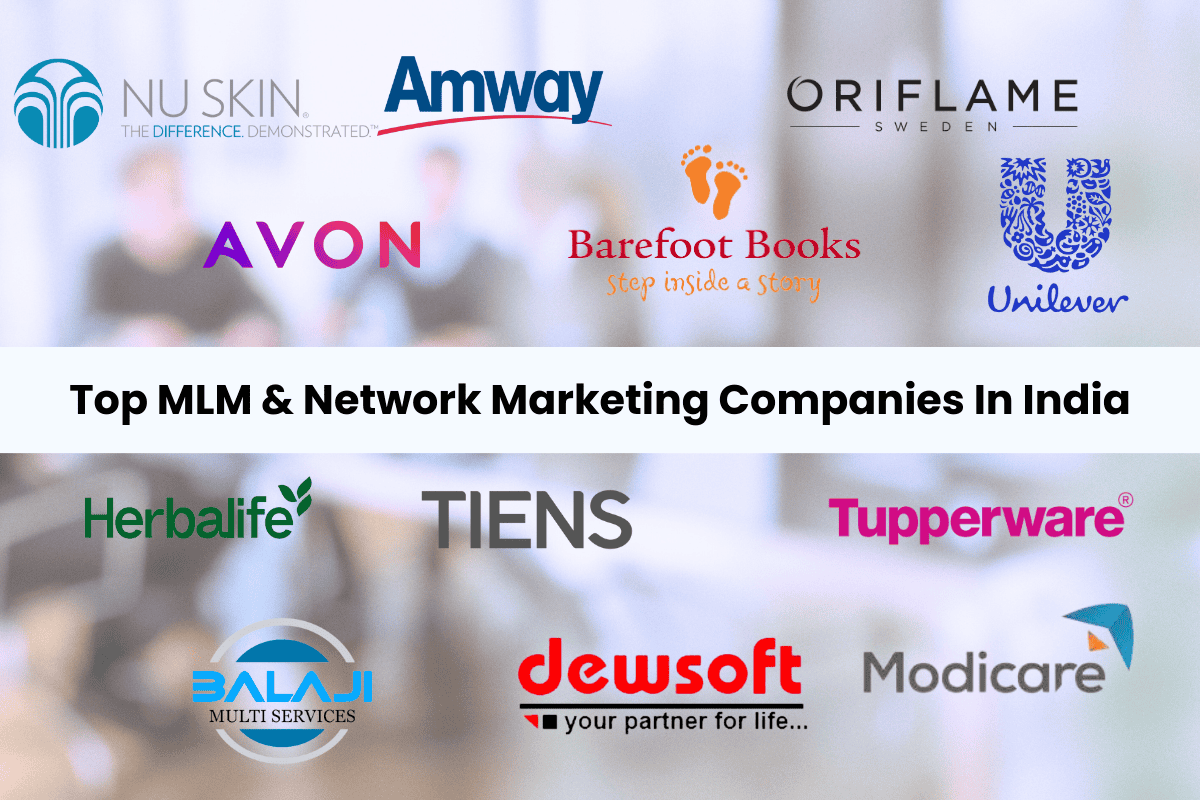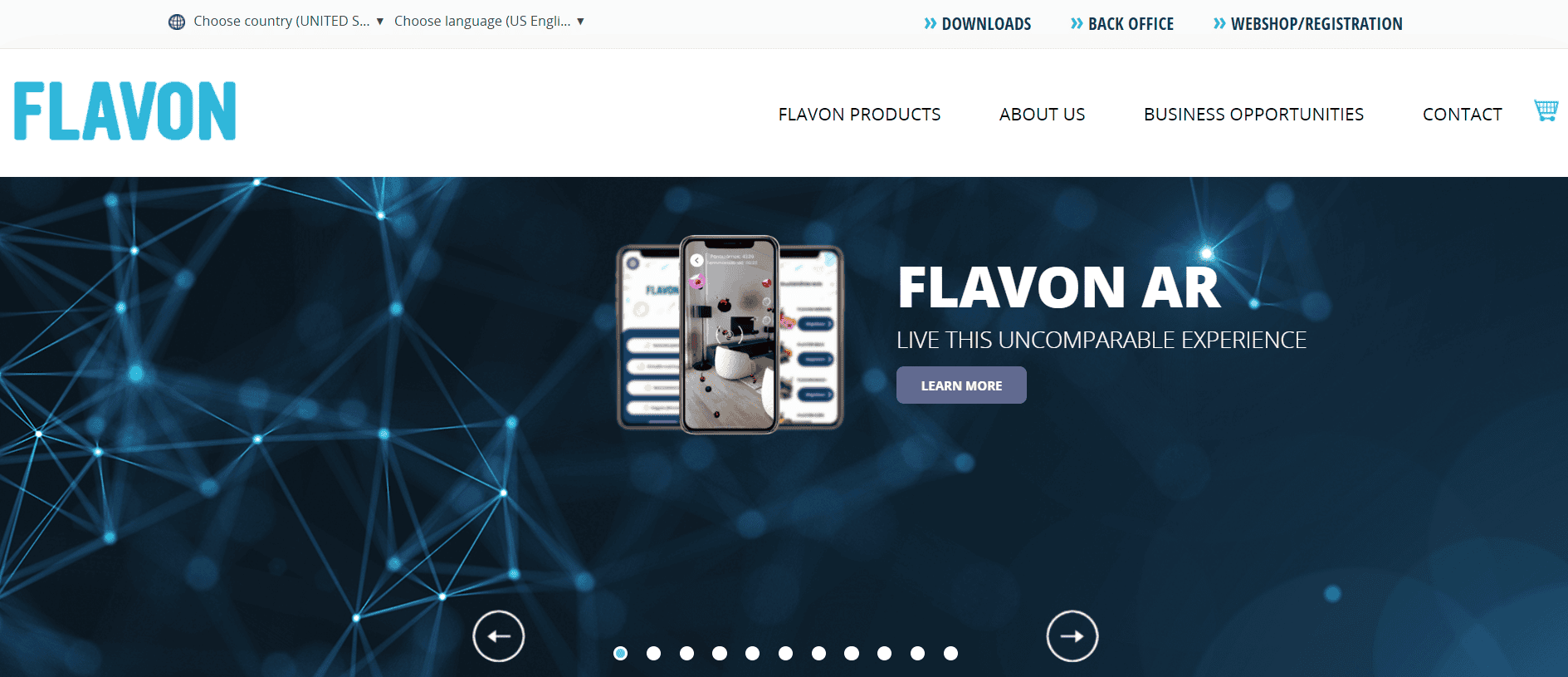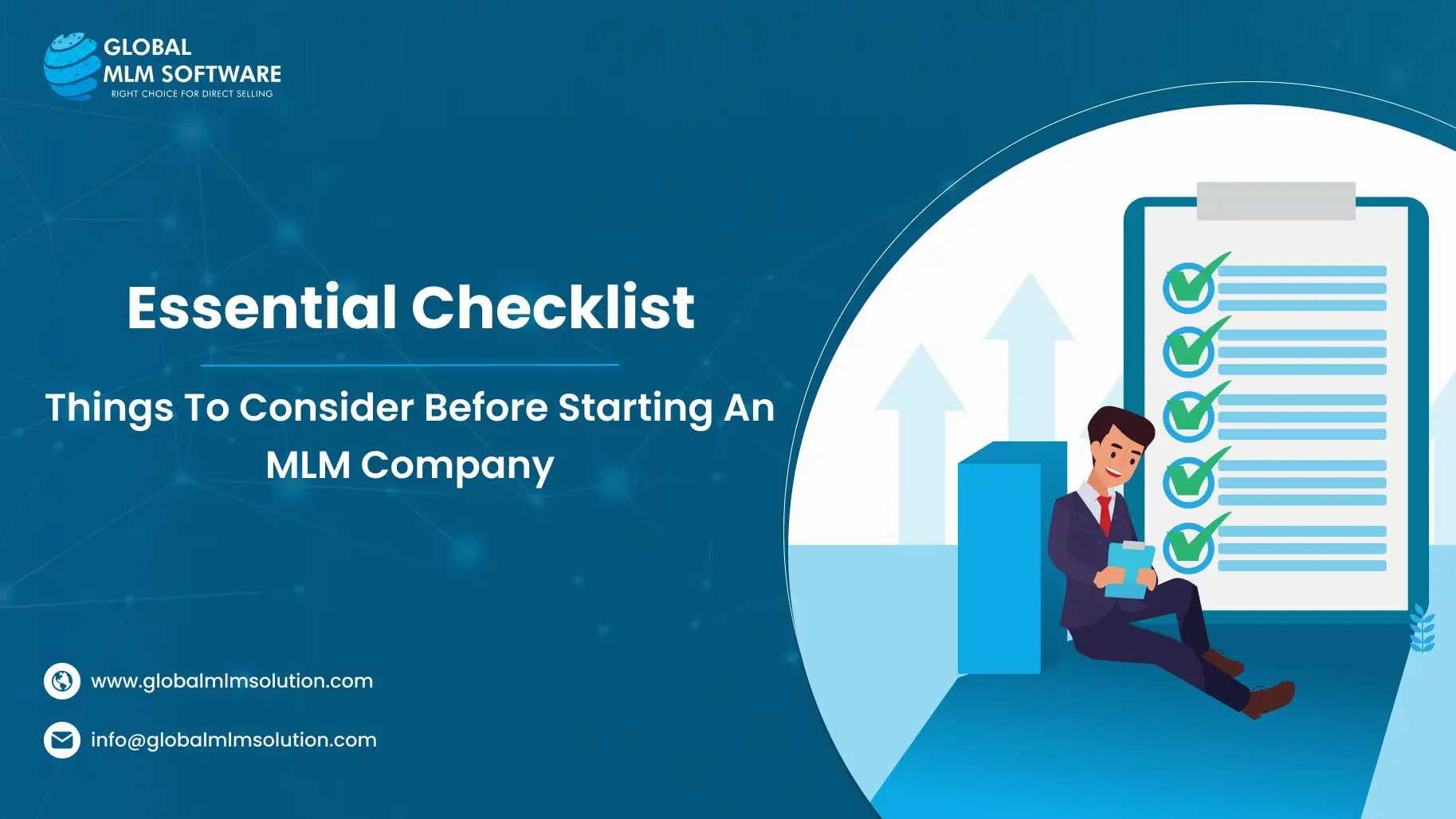- Credit Cards
- Investments
- Terms and Conditions
- Privacy Policy
Top 24 MLM Companies In India
- June 23, 2023
- Money , Tips

MLM (Multi-Level Marketing) and network marketing companies have gained significant traction in India, offering individuals unique business opportunities and the potential for financial success. These companies operate through a network of independent distributors who promote and sell products or services to earn commissions. In this article, we will dive into the world of multi-level marketing and showcase some of the leading MLM companies that have made a significant impact in the Indian market.
What is MLM?
The Multi-Level Marketing (MLM) companies also a synonym for network marketing, referral marketing. It is a very controversial way of marketing as the chances of getting success is very less comparatively it is presented by them, and they always target the easiest prey, who can easily be convinced. An MLM company gets its revenue from a workforce that is non-salaried, known as salespeople, distributors, participants, promoters, consultants, etc. These distributors sell the company product to benefit the company, and they earn their share of commission, which is derived from a pyramid-shaped commission system.
The business model and marketing strategy, which involves a distributor’s income, involve his own sales, and some defined percentage part of the sales of the group they recruit.
All the persons or the group they recruit or convince to join the same MLM company are known as downline for the recruiters. And the best part about working for an MLM company is that you can schedule your work according to your timings and earn a passive income .
The representative of an MLM can sell the product to a consumer and also persuade the same consumer to become the member too because the joining charge is usually included in the price the consumer paid for the service or product. In layman language, one can say that these companies create and manage their network or sales force by asking and motivating the existing sales force to go out, sell the product, and bring more new recruits.
Some of the other common names by which it reaches to people are:
These names also give us a clue about their working structure.
- Network marketing
- Direct selling
- Pyramid selling
- Social selling
- Referral marketing
- Team marketing
- Consumer direct marketing

Top 24 MLM & Network Marketing Companies In India
The Indian market has witnessed the emergence of several renowned MLM and network marketing companies, each with its own range of products, compensation plans, and success stories. Some of the best ones are mentioned below.
1. Balaji Multi Services

It is an Indian origin MLM company with a huge following in India. You can choose from silver, gold, and platinum starter package they are providing, which cost you in the range from Rs 25 to about Rs 6,000.
The approach of marketing they use is providing wholesale service to the consumers and allowing the same to their distributor to sell and also recruit a team of distributer under them is known as their downline.
2. Oriflame

This is a Swedish beauty brand that believes that when a person looks good and feels good, then they have the opportunity to reach their full potential. This Swedish beauty brand is quite popular among Indians, and the brand is highly competitive among cosmetic networking companies in India. They have a wide range of make-up, body items, bath items, and many more.
This network marketing company focused on the direct selling aspect of marketing rather than building a network and standing an army of salespeople. Hence, a participant stands a great chance to earn a lot only by selling the products, and also, the products of this company are very cost-effective compared to other MLM companies’ products.
3. RMP Infotech Private Limited
The company was put into existence in 2001 with the idea of educating and training people with the latest computer skills to match up the global standards of information technology. The company has the ultimate MLM essence (network growth) with a huge business growth opportunity.
It basically deals with the product like software, Information technology products, and training. Their participants can have an uninterrupted income source as they follow a binary compensation plan. They also have a well-organized system which enhances their distributor’s performance as they can complete their task easily and effectively in time.
4. Tupperware

This MLM company is 70+ years old and does its business in more than 80 countries all over the world. It has its roots in India for two decades with the purpose of inspiring women to stand on their own and cultivate the confidence they always deserve to have a better life and make their family prosperous.
The vision they had is to fuel the global communities, especially women, to bring the best out of them and grab all the opportunities coming to them. They are very committed to everyone’s’ profit and growth by generating an acceleration in profitable revenue growth. It is a multi-billion-dollar multi-level marketing company.
5. Dewsoft Overseas

It is an MLM company that is technology-based. It has its working corporate office India in New Delhi. Their participants sell different ranges of software available with them. They offer Interactive Training, Self-Study Books and CDs, Dewsoft Virtual Campus, Web Site Design, Development and Hosting, and Software Design & Development.
They aim to train common people with the latest information technologies skills, personality development skills, and many more.

Amway is a very popular MLM in India, and it is one of the largest networking companies around the globe. They are doing business since 1959. Their Indian corporate office is in New Delhi. The company has a business of more than $8 billion annually, which makes it the world’s largest MLM company.
Their products like cleaners, bath range, nutrients, wellness products, and other quality household products are widely accepted all over India.
Cross-reference: Understanding Multi-Level Marketing
7. Hindustan Unilever

An Indian based multi-level marketing company that is famous worldwide. It has the headquarter in Mumbai. Their product range is very extensive, ranging from food, water purification, cleaners, to all the personal care products.
They are considered as very honest in giving world-class products and services and believe in making money going by the rules. The system Hindustan Unilever uses is very satisfying for their individual independent representative.

Avon, founded in 1886, is a company for women and is a leading beauty company globally with annual revenue of $9 billion. It is popular not only in North America but among Indians for its best quality products in cosmetics and personal care. The prices they have are considered best in the cosmetic industry globally and in India, it’s a familiar name in the network marketing industry.

Either women or men both of any age die to have beautiful skin, especially if they are Indian, then their obsession with fair and beautiful skin is known widely. This MLM company was established in 1984, which is determined to make this world beautiful literally.
They have a wide range of premier anti-aging products and very much committed to go by rules and provide the best quality skincare and nutrition products to its customers. This is a multibillion-dollar company which has registered its name among the top 10 largest networking company in the world.
10. Barefoot Books

It has its existence from 1993, founded by Nancy Traversy and Tessa Strickland. Its headquarter is in Cambridge, Massachusetts. It is a unique MLM company as it allows its participants to sell books of many varieties. It has a great fan base in India. They encourage children’s independent spirits, aims to celebrate the world’s diversity, and build enthusiasm for reading, creativity, and discovery.
11. Herbalife

The company is in existence in network marketing since 1980, was founded by Mark Hughes. The products ranging from nutrition to weight management are very famous among Indians.
The company is among the world’s largest MLM companies. In India, its headquarters is in Bangalore. It has won awards like the Supply Chain Distinction Awards 2009 and 2010 Apple Award. They aim to make the world happier and healthier.

The company has a very strong base in the Indian and Pakistani networking sector. It was founded by Mr. Li Jinyuan in 1995. The headquarter in India is in Chennai.
The products they offer range from personal care to nutritional products. They are pledged to make society healthier and wealthier. Some of their famous products are Ariz Panty Liner, multivitamin tablets and Fat-burning capsules.
Cross-reference: 17 Biggest MLM Companies in the World
13. Global Travel

The company is India based with headquarter in Rajasthan and managed by Madhu Lata and Dev Avasthi. It is among the biggest travel agencies in India with a large fleet of luxury cars and coaches. Their product ranges from tour packages, car rentals, train & airline ticketing services to hotel bookings.
The representative of this company earns their commission on the number of travel bookings they make.
14. Modicare

Headquarter of Modicare is in New Delhi. It offers a great range of personal care, health & wellness, and home care products. It is managed by Samir Modi and founded by Padma Bhushan, Rai Bahadur, Gujar Mal Modi. The company has great market roots in India, and it is still growing rapidly.

It is a very renowned MLM company in the Indian market. It was founded by HaritSanjivani and is headquartered in Rajasthan. Their catalog of products to be sold by their representatives and earn profits is huge. In the Indian market, it is the largest direct selling company with a huge network across the country.

It came into existence in 1956 and is founded by Jan and Frank Day and managed by Mauro Schneidman. Its product ranges from cosmetics, skincare to personal care. One of its famous products is Royal Skin Care Jelly. In India, it has a great fan base in the cosmetics market. They have a large range of cosmetics to offer to their customers.
17. Immunotec

This is a networking company based in Canada that came into existence in 2005 and was founded by Dieter Beer, Chuck Roberts, and John Molson. Their famous products are Immunocal, Probiotic 3+ with Cranberry, and PNT 200.
The company is built on the idea of improving their consumer’s health and wellness and also their wealth. It is deeply rooted in the Indian market with super quality products ranging from high-quality nutritional supplements to products that make life more manageable.
18. Guru SSR India

It is a direct-to-consumer company that was founded by Sunil NandlalKeswani and Kanta Sunil Keswani. Their headquarter is in Mumbai, and they grow to fame by their famous product Noni Fruit Juice. It is among those Indian MLM companies which allow its independent participants to sell health and wellness item from their selection. Their earning comes from the commission of products they sell and some parts in the percentage of earnings of their downline too.
Cross-reference: The good, bad, and ugly of direct selling firms in India
19. DXN Global

It is a Malaysian based networking company founded in 1993 and has worldwide operations. This company is also very popular in the Indian subcontinent. Its product ranges from food and beverages, skincare and cosmetics, dietary supplements, personal care products, water treatment systems, and household products.
20. Flavon Max Club

It is a European network marketing company that is very famous among Indians. It was established in 2004 and came so far since then. Their suppliers are from Hungary, Italy, France, and Germany. They have also won many awards. They have a great range of health and well-being products.

They focus on enriching people’s lives as they allow people to start a home-based business. They are so much involved in the Indian market. They proved themselves as the source of extra income for people. They have products ranging from health, homecare, personal care, cleaners, etc.
22. Forever Living Products

They came into existence in 1978 and is among the top 10 network marketing company in India. The products are aloe vera based on health and wellness. Their business is not only confined to India but also spread all over the world. In India, their headquarter is in Mumbai.
It is a company with a great compensation plan, great products, and also a great reputation around the globe. One can say that this company is worth exploring.

A well established and known player of networking industries for a long time. It is among the leading direct selling MLM companies in Asia. Their focus is to enable people to rise through solutions that power peoples’ entrepreneurship spirit and enhance their lifestyles. The products they offer include a wide variety of health and wellness, beauty, jewelry, watches, technology, and travel and tourism solutions also. Hence also known for providing meaningful products and services in a diverse market.
24. Vestige Marketing Pvt. Ltd.

It is a networking company that came into existence in 2004 and was successful in making its place in the sector of multi-level marketing. In world-class health and personal care products, it is a leading player with the motto of “spreading wealth through wellness” all over the world. In India, they have about 2000 or more online and offline sales outlets. They have GMP certified state of the art manufacturing facilities.
Cross-reference: Wall Street: Still Confused About ‘Multi-Level Marketing’ But Starting To Hedge Bets
Factors to Consider before Selecting a MLM and NM company
As there is a huge chance to get cheated by a representative of any MLM company so you need to be equipped with all the information while dealing with one of them so that you can counter their so-called factual data and save yourself.
Beside of being wise while selecting the best MLM or networking company for yourself, you also need to consider these factors:
- Product or Services: A networking company is always known for the product or services it chose to sell. It should always sell some unique concept that is affordable to the consumer it is targeting.
- Leadership: You must check the leadership of the company; they must be talented enough to create a sustainable business model. The leaders of that company should be very experienced and able to understand the nuances of the business their company is dealing with and the market scenario where they are going to compete ultimately.
- Business History: You must check the history of the company, how old it is, how much profit it is making, how far it is from the race of being number one. The company you are choosing must be reputed in the market and have managed to sustain all the way for at least five years or more.
- The Compensation Plan: The program an MLM company is offering should always be robust and has the potential to hold the attention of the current prospects. The compensation plan of a company in benefits tells all the stories about that company’s capability to maintain its sales momentum.
- Availability of Training: The company you are considering must have the facility to train the new recruits. They should provide all the required facilities, business material, and adequate training to the new bees so that they can plan an effective marketing strategy to sell the products and bring prosperity to the company.
How to choose the right MLM company?
After going through the above list of network marketing companies’ options available in the Indian market, a dilemma about choosing the best among them can find its way in your head.
To get out of this confusion, keep these simple things checked, and follow the mentioned process.
- Choose what product or services you can sell easily and effectively and interested in its promotion
- Compare at least 5 MLM companies in Indian selling the same product you are interested in selling.
- Before choosing one among them, try their products first to be confident and effective while recommending it to others.
- Don’t forget to review the compensation plan of the companies you are considering.
- Make a comparison chart of all the respective companies’ leadership, stability, and reputation.
- For better understanding, always try and interview some successful people from all the companies.
- In the end, evaluate all your gathered information, compare them again, and choose the one which makes the most sense to you.
In conclusion, MLM and network marketing companies have become a significant force in the Indian business landscape, providing individuals with opportunities to embark on entrepreneurial journeys and achieve financial independence.
With their focus on direct selling, team-building, and commission-based earnings, these companies have created avenues for people to build their own businesses and generate income.

Sushma Singh
Sushma is an expert in personal finance and business with lots of experience. She loves helping people understand how to make money online, build income without much effort, and become financially independent. Focusing on easy-to-use apps and fun games, she shows people the best ways to earn money online.
Share this post on social
5 thoughts on “top 24 mlm companies in india”.
I am surprised to see here that “Eazyways” which is the best MLM company in India, is not on the list. I am talking about one Indian company which working in this direct selling Industry for more than two decades and the name of this company is “Eazyways Arogya Healthcare Private Limited”. This is one of those companies who you call cent percent desi or swadeshi. It is a big achievement to working in the direct selling industry for two decades, so we can say “Eazyways” is one of the most stable and one of the trusted direct selling companies in India. I can say again “Eazyways” can be a very good choice for those people who are seeking an opportunity to build their carrier in network marketing, Eazyways can be a no.1 choice in networking because of its wonderful business plan and platform.
Thanks for writing it. I have been researching this topic for my article. I have got some good insight from it. Thanks again
Comments are closed.
Related Posts

How to Earn Money by Playing Games
Ways of earning through gaming are diverse, catering to different preferences and skill set.

How to Start a Business with No Money
Launch a business with limited funds through strategic planning.

30 Most Expensive Dresses Ever Made
Luxurious dresses broke records with sky-touching prices, reflecting elegance and craftsmanship.
From Launch to Prosperity: Your Full Guide to Running an MLM Business

Launching a business isn’t just about having a brilliant idea—it’s about creating a robust framework for success. Entrepreneurs who thrive don’t merely rely on passion; they strategically align their ventures with growth objectives, customer needs, and innovative solutions.
Starting a business requires taking steps forward to achieve growth, or you will revert back to safety. The same applies to MLM businesses, so let’s understand all about the MLM business model and dive deep into a step-by-step guide to successfully starting your own multi-level marketing company.
This Article Contains:
Understanding Multi-Level Marketing (MLM)
An mlm business model: how does it work, getting started with an mlm business, how to grow your mlm business, final words.
MLM, also known as network marketing, is a legitimate business strategy employed by some direct sales companies to sell products or services.
Companies use multi-level marketing (MLM) as a business model to encourage their independent business owners or distributors to actively recruit new members into their business. This recruitment process results in the creation of a hierarchical structure known as a downline.
Here’s how it works
Existing members (often called distributors) promote and sell the company’s products or services to others. They also recruit new participants into the business.
A distributor earns a percentage of the sales of their recruits.
Participants are encouraged to bring in new contractors, creating a network or downline.
Multi-level marketing is significantly different from traditional businesses. Let’s understand the difference between MLM and traditional business models to gain more clarity on their working:
After understanding the differences, one may ask how an MLM business model works.
This complicated-looking business model, on the contrary, is simple and straightforward . Independent business owners reach out to interested individuals or members with a plan to create a win-win situation. Members who are interested in starting their own business and gaining financial freedom by being their own boss start their MLM business. Every individual involved in an MLM multi-level marketing is a business owner.
To understand how the MLM business model works one can think of a pyramid. The first independent distributor is hired directly by the direct marketing company. Let’s say in our example is Mr. A. Now, he recruits 5 more independent distributors who each turn around and recruit 5 more independent distributors, and so on.
Mr. A, as the sponsor or upline, recruits individuals into the multi-level marketing (MLM) company. These recruits, along with everyone they bring in, form his downline.
Also Read: Upline and Downline in MLM
Understanding the direction of these relationships is crucial because it directly affects the earnings within the pyramid. In most MLM setups, all distributors contribute a portion of their earnings both to the company and to those above them in the hierarchy.
Remember, clarity in these relationships ensures transparency and fair compensation for all participants.
Individuals starting their own MLM business can earn as follows:
An independent business owner's commission on sales.
Commissions from people who started their own businesses under them.
Individuals wishing to join the multilevel market may have to pay the registration fees. This may bring doubt about the legitimacy of MLM-based companies.
As discussed above, the multi-level marketing model is different from the traditional business model. The traditional blueprint model won’t be much of a help when building an MLM business. So, let’s dive into the step-by-step checklist to get started and eventually build your MLM business.
1. Choose your Product/Service
The first step, without a doubt, must be choosing your product or service. The product should appeal to buyers and encourage distributors to sell further. For this, it becomes essential to identify, research, and test potential products and services that have a Unique Selling Proposition (USP) or are distinct from similar products/services.
Next, shortlist products or services that can deliver 5X value to your end customer compared to existing products/services and test the interest levels of your target customers and potential distributors.
The other crucial factor in choosing a product or service is strong customer demand to ensure sales success for representatives. As a result, your MLM company will also be able to generate profits from retail sales to consumers, rather than just recruiting representatives. Consider utilizing digital marketing services to gather the necessary data for this process.
2. Draw up a Detailed and Realistic Business Plan
In a multilevel market, this step is again crucial to the success of your MLM business. One might hit a dead end if proceeding without a detailed and realistic business plan. A plan will clarify how to proceed and define your business goals, purpose, and vision. Additionally, a well-crafted business plan can attract potential investors if external funding is required. But what are the key points that your MLM business plan must include?
Define business objectives
Define correct business objectives after researching your niche; they must be challenging yet realistic.
Analyzing the market
Develop sample profiles for your target customers and key competitors. Determine the size and opportunities of your niche market. Identify your product and service's fit in the market by compiling and analyzing the data. Make sure there are no potential barriers.
Profit and loss projections
Based on the financial goals, market research, product and operating costs, estimate your anticipated revenues, profits and losses for the first five years.
Sales and marketing
An effective sales and marketing plan should outline how to promote products and services to buyers, identify how many distributors are needed, and map out marketing strategies, website designs, and budgets.
It is important to note that the above list is not exhaustive, and more pertinent points can be added.
3. Construct a Compensation Plan
Once you have selected a product or service and created a business plan, the next step is to develop a compensation plan for your MLM company.
You will use this plan to lay the foundation for your direct selling business, defining the terms and conditions for earning income, commissions on direct sales, or as an override bonus earned on downline product sales.
It is essential to balance your compensation plan to ensure it is a win-win for all parties involved. The plan should be reasonable, attractive to distributors, and profitable for the company. This will help you develop a compensation plan that is fair, competitive, and sustainable for your MLM business.
4. Raise Funds for Your MLM Business
Commencing a multilevel marketing company without securing adequate capital is ill-advised. So it's important to raise funds. There are two common ways by which MLM companies raise funds in multilevel markets, i.e., debt financing and equity financing.
Debt Financing involves applying for and receiving an interest-bearing loan from institutions like credit unions, banks, or Non-Banking Financial Institutions (NBFIs). On the other hand, Equity Financing entails exchanging ownership stakes in the company for cash investments sourced from various entities, including family members, friends, and investors, or through Initial Public Offerings (IPOs).
One can employ a combination of these financing strategies based on your company's vision, unique requirements, and expansion plans. Ultimately, the most suitable approach should be determined by considering the multiple factors discussed, as well as maintaining a healthy debt-to-equity ratio.
5. Set up a Merchant Account
A merchant account enables businesses to accept debit and credit card payments and is like a business bank account. It can also be considered as a bridge between your business account and your customer bank account.
Setting up a merchant account for your Multi-Level Marketing (MLM) organization requires careful consideration. Thus, before applying for a merchant account, ensure the following steps are taken:
Identification
Confirm that the individual signing on behalf of the company meets the criteria for being a principal signatory, such as possessing good personal credit.
Website Presence
Enhancing your website with comprehensive information about your business and products can significantly impact payment processors' decision to collaborate with you.
Application Details
Before proceeding, inquire about the refund policy for setup fees, as some payment processors charge non-refundable application fees, regardless of account approval. It's crucial to clarify such details upfront.
Given the unpredictable growth patterns and legal complexities linked to MLM businesses, anticipate a longer approval process for a merchant account. Initiate the application early to allow ample time for approval before your business launch.
When applying for a merchant account, provide detailed information about your business, including chargeback ratios, return policies, and compliance with regulatory standards.
6. Select the Best MLM Software
MLM software is the backbone of your business, handling everything from compensation plans to automating API access, electronic transactions, party plan solutions, promotions, and more. It's crucial to choose software that can scale up or down depending on your current and future needs and provide end-to-end solutions.
Take the time to research different solutions and identify companies with published case studies and positive customer reviews.
Also Read: 12 Must-Have MLM Software Features to Drive Growth to Your Business
7. Hire an MLM Attorney
Having an experienced attorney taking care of the legalities is always a good idea. An experienced attorney can support you at the various stages of your MLM business. Their expertise can guide you on product regulatory compliance, labeling, compensation structure, and international expansion.
When your company sells products through distributors, it's important to ensure their claims about the products are accurate. The FTC oversees these claims and looks for any false or misleading information about how much money can be made or the health benefits of the products. Having an MLM attorney on your team means you have a knowledgeable resource who understands the current laws that regulate the direct selling industry.
Even if you think you don’t need an attorney, reality dictates that at some point in time, your company will need one. So, it is better to build an attorney-client relationship as a proactive step.
8. Keep all Your MLM Records
The policy and procedure manual is a fundamental document for an MLM company, encompassing a wide range of topics, usually 50 or more. It is tailored to your specific business model, products, principles, and ethics. Establishing clear and thorough documentation is essential for an MLM company. Policies and procedures, such as those outlined below, form the core of your business rules and operating processes.
Products and Marketing Materials
Make sure you protect your products and marketing materials, whether they are physical or digital.
Customer Data Protection
Comply with local and global privacy laws to safeguard customer data.
Compensation Structure
Ensure it aligns with actual sales to real customers, avoiding misrepresentations.
Compliance Considerations
Monitor and manage claims representatives make about products and earnings, staying compliant with federal law.
When developing documentation, avoid duplicating content from other companies. Instead, work closely with an MLM attorney to create customized templates or draft original documents specifically for your business. Keep in mind that while it might seem tedious now, meticulous documentation will benefit your company in the long run by reducing legal risks and protecting your brand reputation.
9. Prepare for the pre-launch
You're on the brink of success, but there's still more to uncover about your market, customers, and products. For this, you can conduct a pre-launch, also known as a soft launch, which is essentially a limited release of your product or service to a much smaller audience. You can take advantage of a pre-launch, and this can become a stepping stone to success for your MLM business. Because it can provide invaluable insights about your products from your target audience.
This phase, ideally initiated at least 90 days before the official launch, this period can be used to build awareness, interest, and even pre-orders. By leveraging strategies such as sneak peeks, promotions, and limited availability, you can validate your product, generate excitement, and lay the groundwork for a successful launch. Additionally, creating a pre-launch video tailored to your product's price point is an effective way to captivate potential customers and generate anticipation.
10. Get ready for the final launch of your MLM company
Now is the time to launch your MLM business, but before you launch it, you need to assess your success by revisiting your business goals. These goals will serve as Key Performance Indicators (KPIs) to evaluate the success of your launch. To ensure each KPI is measurable, break down each goal into quantifiable elements.
As you execute your launch, stay on top of your KPIs and supplement them with insights from your representatives and customers. This will help you validate your goals and make necessary adjustments quickly.
To grow any business, the right plan of action is important. For this, we will cover the two fundamental pillars.
1. Select the Right Business Model
Choosing the right business model is crucial for your MLM enterprise, and there are several compensation frameworks to consider. The four most commonly used models are binary, matrix, uni-level, and stair-step breakaway.
The binary plan involves creating two lines of subordinates, with commissions based on the weaker leg's sales. The matrix plan has a limited-width strategy, with a specific number of distributors at each level. The uni-level plan is boundless in width and depth, with all distributors operating on the same level. The stair-step breakaway plan involves developing a team and establishing your crew after reaching a specific level.
When selecting an MLM compensation plan, consider your business goals and product. Your startup should provide a compensation scheme that benefits both the company and its distributors.
2. Solid Strategy and Team
To build a successful MLM startup, you need a solid strategy to hire dedicated and motivated individuals who believe in your product and vision. Above all, you need professionals who excel in network marketing and communication, as they will be responsible for promoting your products and recruiting others to do the same.
To hire the right professionals, start by identifying the positions you need to fill in your team. Then, recruit individuals based on their job profiles, skill sets, experience, and interview performance. During the interview, ask questions about their motivation for applying to the job to ensure they align with your vision and goals. There are various ways to find the right professionals, but it's essential to prioritize hiring individuals who share your passion and can help drive your business forward.
Do you want to kickstart your MLM Business?
Our reliable MLM software is the answer!
To build and grow your business, we provide the most steadfast and easy-to-use MLM software.
Business is a dynamic landscape where every decision can either propel your company forward or slow it down. As a result, an entrepreneur's decision can mean the difference between exponential growth and stagnation for their business. Choosing an MLM software can be one of those decisions.
Global MLM Software is one of the best marketing systems. Whether you are a new or established company, our MLM software is easy to use and has an extensive suite of tools to help your business build and grow. With minimal customization, you can also get your business off the ground quickly.
1. What are the common ways to raise funds for an MLM business, and which is more suitable?
MLM companies commonly raise funds through debt financing (interest-bearing loans) or equity financing (exchanging ownership stakes for cash investments). The most suitable approach depends on the company's vision, unique requirements, and expansion plans.
2. What is MLM, and how does it differ from traditional business models?
MLM, or multi-level marketing, is a legitimate business strategy where independent business owners sell products and recruit others, creating a hierarchical structure. Unlike traditional businesses, MLM relies on a commission-based structure and emphasizes individual sales.
3. How can I choose the right product or service for my MLM business?
Choosing the right product involves identifying, researching, and testing potential products with a Unique Selling Proposition (USP). Ensure the product appeals to buyers, encourages distributors to sell, and has a strong customer demand.

Want to have MLM Software for scalability? Here's the Solution
We provide best and reliable MLM Software to establish or kickstart your business in minutes
We invite our readers to share their insights, thoughts, or inquiries regarding the content featured in the blog above. Feel free to comment in the section below or reach out via email to 📩 [email protected] .
For sales-related inquiries and to connect with our product experts, please send an email to 📩 [email protected]
Leave a Reply
Your email address will not be published. Required fields are marked *
Recent Blogs

Cybersecurity Plan for MLM Industry and its importance

Top 11 Things to Consider Before Starting an MLM Company (2024)

Top 11 things to Consider before Joining an MLM Company (2024)
Liked Reading this blog ?
A world of information is open for you.Subscribe our newsletter.
We hope you enjoy reading this blog post.
If you are looking to start your Network Marketing Business or Scale 10x using Global MLM intelligent platform, just book a call
- Call Global MLM for MLM software requirements Join via Telegram channel of Global MLM Get connected with Gobal MLM through whatsapp
- [email protected]
- Global MLM Software Facebook Page
- Global MLM Software Twitter Page
- Global MLM Software Youtube Page
- Global MLM Software LinkedIn Page
- Global MLM Software Instagram Page
- Skip to primary navigation
- Skip to main content
- Skip to footer
LaunchSmart™ MLM Startup & Party Plan Consultants
The Direct Selling Experts
How to Write a Successful MLM Business Plan
July 25, 2012 By Terrel Transtrum
This article will help you refine how to write a successful MLM business plan. As your ideas and dreams take root for starting and running a successful MLM, you will also realize that there is a lot to do. Smarts and hard work will help.
What Is a Successful MLM Business Plan?
A successful MLM Business Plan is a comprehensive written presentation of your business idea. A good plan outlines what the business really is, what it will do, how it will be funded, how it will achieve its objectives, and how it will be launched. In addition to the standard elements of business plans, the successful MLM business plan tackles such complexities of such as forecasting compensation plan payouts, growth modeling, inventory planning in fast-growth environments, cash flow, and distributor attrition (inactive accounts). An MLM Business Plan is especially useful for MLM startups seeking potential founding distributors, investors, and manufacturers who will offer favorable terms.
How Do I Get Started?
Start preparing your MLM business plan by tackling key questions.
- What will you really be offering and why will people buy it?
- Who will be the visionary that drives the business forward?
- Where will you get the money to launch and run your business?
- What market need will you be satisfying?
- How will your growth strategy work, and what assumptions are you relying on?
A successful MLM business plan should have the following sections:
1. Executive summary: This summary holds the reader’s attention and sparks their thinking as it reinforces your capabilities to effectively present your ideas.
2. Business description: This presents the framework for the MLM business plan and what it’s all about, what you are truly taking to market, why you have selected the MLM business plan for your marketing channel, and so forth.
3. Market strategies: After researching the target market and the true needs that your business offering will meet, present your findings and ideas, how the new MLM business will be positioned in the market, its differentiators, and what circumstances will assure success.
4. Competitive analysis: Present competitors, their products and strategies, and how the MLM startup will have a competitive edge. Look beyond the world of network marketing and direct selling, for much of the competition exists in places you may not be looking.
5. Design and development: Present how will you produce, package, and market the service or product. How will its design and function set it apart? What will it look like when it’s ready?
6. Operations and management plan: Present the basics of how distributors will be served, how the business will operate, and what are the underlying operations strategies from the first day of launch.
7. Financial factors: The growth and financial model must include the discipline of income statement and cash flow analysis, and the better practice is to present key ratios that investors consider.
Potential investors often expect an appendix that presents the leadership team, supporting market research, and information on which you have relied to reach your decisions.
Starting and running a successful MLM business is exciting, and doing your homework is vital. In addition to the resources available at the LaunchSmart website, including model business plan, financial forecasting for the MLM business plan, and a host of useful resources, the US Small Business Association offers an online tutorial on writing a business plan
The idea of starting a business is exciting, and doing the homework is critical. In addition to tools and services that we provide, the US Small Business Administration offers an online tutorial on writing a business plan (http://app1.sba.gov/training/sbabp/index.htm). We can also help you to fill in the important details relating to MLM Business Planning, or feel free to contact us for assistance in writing your complete MLM Business Plan.
- Terms of Service
- Privacy Policy
How to Start an MLM Company: An A-to-Z Guide
Start an mlm.
So, you’re thinking of starting a multi-level marketing (MLM) business. You’re passionate about the product offering you have in mind. You believe there are lots of other people who would be passionate enough to join your direct selling business as independent sales representatives. And you can see a path to growth for the company. What else do you need to start an MLM?
While product ideas, passion, and a path to grow are a great place to begin, starting a successful MLM business also involves significant research and decision-making related to the company structure, the sales team, and marketing strategy. Whether you’re considering launching an MLM company or you already have, take a look at this A-to-Z guide outlining key considerations and steps toward building a thriving direct selling company.

The appeal of the MLM model
Adapting a direct selling retail model means a company’s products or services are sold directly to consumers by a team of independent sales representatives. Rather than traditional retail stores, MLM companies rely on their field sales team to build one-to-one – direct – relationships with a network of customers. Through these relationships, the MLM sales representatives sell the company’s products and services and recruit others to join the organization as sales representatives.
With less capital and lower fixed costs, the MLM business model offers an appealing and cost-effective alternative to traditional retail for entrepreneurs looking to get a product into market and ramp up sales quickly. Today, the MLM industry encompasses a range of product categories, including health and wellness, clothing, jewelry, cosmetics, nutrition, home goods, and leisure. Successful direct selling companies can also be found across the insurance, energy, and educational categories.
As the U.S. workforce continues to prioritize work-life balance and flexibility, the direct selling industry is booming. As of 2020, the Direct Selling Association reports that more than 7.7 million people work as MLM representatives in the U.S., which is a 13 percent increase over 2019. Overall, direct selling companies achieved a 14 percent annual sales growth rate in 2020, equaling a total of more than $40 billion in retail sales for the year.
Assess the MLM model for your business
To determine whether the MLM business model is a good fit, start by evaluating how well the following elements align with the vision for your business.
- High-quality products and services: Because of the direct relationships between MLM representatives and their customers, successful MLM companies focus on differentiating themselves based on the quality of their products and services combined with a personalized customer experience. Typically, MLM companies offer premium-quality products and services delivered through a sales distribution model that allows them to price their products at a margin that’s approximately 5x higher than the cost of goods. While the margin will vary slightly based on the type of product or services, it’s necessary to accommodate a competitive compensation program for the MLM company’s independent sales representatives.
- Elevated customer experience: To succeed at delivering premium products that are priced with enough margin to fund the business and the sales team, MLM companies must deliver high perceived value to their buyers. The one-to-one direct sales approach – whether it happens face-to-face or virtually – is ideal for products and services that benefit from a demonstration or a personalized explanation of how it meets a customer’s individualized needs. When MLM sales representatives are able to convey the value of the product or service, as well as the value that they bring to the experience, they connect with customers on an emotional, rather than transactional, level. As a result, customers feel good about making a purchase and building a loyal relationship with an MLM representative. In today’s highly automated and often impersonal world, customers appreciate a personalized shopping experience. In fact, research shows that three in four consumers say experience is an important part of their purchase decisions.
- Independent salesforce: MLM representatives are not employed by the MLM company. Instead, they work on a 1099 basis, which lowers the overhead costs for the company. For the representatives, joining an MLM company provides a turnkey way to pursue an entrepreneurial opportunity by creating and running their own business on either a full-time or part-time basis, without significant startup costs or infrastructure investment. The MLM company provides field representatives with the resources they need, including products, marketing, and MLM software tools that enable the representative to make online and offline sales and handle the operational aspects of running their business and building a downline team of representatives. Along with these resources, the MLM company also provides competitive compensation that motivates and rewards the representatives’ sales activity.
Build a business plan
As with any business venture, having a solid business plan is crucial to start an MLM. When launching an MLM company, create a detailed three-to-five-year business plan to provide a roadmap that shows not only the destination (long-term goals) but also the “turn-by-turn” directions for how you are going to get there.
A good business plan outlines the company’s purpose and goals, along with short-term objectives and actions. It should be a written document that you can share with other company leaders and update and refine as the company and market opportunities evolve. Your business plan is a living document that you will refresh at least annually, adding detail so that it always outlines a plan for the next three to five years.
One of the most important attributes of a solid business plan is to ensure that all of the numbers, objectives, and projections are grounded in fact. Conduct research – formal or informal – to understand customer needs, target market size, and the competition. Use this information to craft realistic revenue, customer, and sales objectives for at least the next three years. Based on these objectives, calculate how many MLM sales representatives you will need to recruit and onboard in order to achieve them. The key is to set challenging growth objectives that inspire the team to push themselves, but not to set such unrealistic goals that they act as a demotivator because they are impossible to achieve.

Spend the time upfront to research and develop the following components of your MLM business plan:
- Product assessment: For direct selling companies, the product or service is the centerpiece of both sales and recruiting. It’s worth it to do customer research and product testing to determine how the product meets the needs of potential customers, how interested they are in the product itself, and how willing they are to purchase it. If you can, conduct formal market research through methods like surveys, focus groups, and product testing. Supplement the formal research with informal insights gleaned through customer and sales representative interviews. Through this research, you will also be able to test how customers value your products and solutions by gauging how much they are willing to pay.
- Market assessment: One of the secrets behind successful direct selling companies is that they’re not aiming to sell to everyone. Rather, they target a defined market niche that’s well-aligned to their products, receptive to the direct selling model, and large enough to support the company’s long-term growth objectives. A niche market has distinct needs and preferences that make it unique and can be defined based on demographic attributes like gender, age, or income level, and psychographic attributes like customer interests and values. When defining a niche market for your company, “niche down” so that you’re as specific as possible. This way, you’ll be able to be more targeted in your offering and positioning. However, before finalizing the target niche segments, do a comprehensive market assessment to understand the size and potential for growth.
- Sales projections: This is where you map out the details of exactly how many sales made by how many representatives it will take to reach your objectives in years one, two, and three of your business. Whenever possible, base your projections on actual sales results and data-based analysis of future results. You should always factor in representative recruiting variables, including experience levels and how long it takes representatives to onboard and begin selling. When you crunch the numbers and evaluate best- and worst-case scenarios, you come up with viable projections that you can use as a measure from month to month and adjust based on what you learn about your products, field sales team, and the market overall.
- Contingency planning: As part of your planning, build out detailed contingency plans for what you will do if results don’t go according to plan. This includes planning for faster than anticipated growth. Consider supplier, manufacturing, and distribution needs to develop a plan for how you could scale if customer demand outpaces your projections by 10 or 100 times. This will help you anticipate what it takes to scale your business and ensure that you’re prepared to capitalize on market opportunities.
- Corporate structure and legal advice: During the business planning phase, you should also consider how you want to structure the company at the corporate level in the short and longer terms. Which roles at the corporate level need to be filled on day one? And how much direct selling experience will the ideal leadership candidates have? (More is better!)
Along with the people in the corporate office, you should make a decision early on about whether you want to start the mlm company as an LLC (Limited Liability Company) , an S Corporation , or a C Corporation . While an MLM company can operate as a Sole Proprietorship or Partnership, the LLC and Corporation structures offer liability protection and tax options. An LLC limits an owner’s personal liability, provides additional options on how the business is taxed, and offers flexibility on how many owners a company can have. The S Corp structure – for companies with 100 or fewer shareholders – offers the benefits of incorporation, along with the federal tax advantages of a partnership. A C Corp structure also limits owners’ personal liability but is subject to corporate income tax and is often used by companies that are seeking venture capital investments.
At this point in your business planning, it’s a good idea to consult with an attorney with experience and expertise in the MLM industry who can review your plan, advise about the appropriate corporate structure, provide guidance regarding compensation strategies and compliance, and identify opportunities for patents, trademarks, and copyrights.
Decide on an MLM genealogy structure
Along with a corporate structure, you’ll need to determine the MLM genealogy that best fits your products, business plan, and growth strategy to start an MLM company. Much like a family tree, an MLM company’s genealogy structure provides a hierarchical record of the independent field sales representatives based on the representative who sponsored them and where they sit in the overall organizational structure. As representatives build their own businesses, they recruit new representatives for their downline teams and add levels to the MLM genealogy tree.
The genealogy structure is critical because it is a primary driver of the company’s compensation plan, and while it can be adjusted and enhanced as the company evolves, it is difficult to change the underlying structure of the compensation plan down the road. The basis of an MLM company’s genealogy is to define the number of representatives included in the plan’s “width” and “depth.” Depending on the structure selected, the width and depth can be fixed at a certain number or unlimited. For example, a Binary MLM compensation structure has a fixed width that includes two representatives, but the depth or number of levels within the structure is unlimited. As new sales representatives enroll, they are placed in two-person-per-level tiers below the initial two-person frontline.
The most common compensation structures used by MLM companies are Unilevel , Binary , Matrix , and Hybrid. With one of these structures as the foundation, many MLM companies elect to bring in elements from other plan types to help drive specific growth. Each structure offers different options for defining revenue opportunities for field sales representatives while also managing the company’s overall bottom line.
Related: MLM Genealogy Trees – and How They Grow
In addition to defining the compensation plan, outline complementary recognition that’s designed to motivate and reward successful sales representatives. This should include creating criteria for a series of ranks within the sales organization that come with a distinct title and perks that inspire representatives to want to achieve them. Strike a balance between making the ranks attainable without making them too easy or too difficult.
You’ll also want to supplement your compensation plan with other incentives, such as bonuses and sales contests. Strategically planned bonus opportunities can play a pivotal role in your MLM company’s sales growth. For example, many MLM companies offer a starter bonus to reward new representatives when they make initial sales after joining the organization. This type of extra compensation gives reps a taste of the financial rewards available to them over time and helps to keep them engaged. Research shows that when MLM sales representatives have early success and make their first sale within two weeks after joining, the rep stays with the company for an average of six years – well above the overall average MLM retention rates for sales representatives.

Choose your MLM software
Another critical step when starting an MLM company is selecting the MLM software that will serve as the operational hub for the business. Along with choosing an MLM software platform that provides the technology tools you need to run your business and integrate with your corporate back-office, you’ll want to work with an MLM software provider offering solutions that can be seamlessly added as your business grows. Just like selecting a genealogy structure, determining your MLM software is a major decision that will impact all facets of the company.
As a start, look for solutions that simplify and automate everything from tracking the organization’s genealogy tree through commission payout calculations and comprehensive reporting. Next, evaluate the software platform’s tools for facilitating sales. The best MLM software provides a consistent Ecommerce experience through replicated websites that include responsive design for mobile devices and shopping cart features that enhance browsing and buying. For example, choose MLM software with shopping cart capabilities like product categories, filtering, and search built in. You’ll also want software that enables you to tag new or best-selling products and alert shoppers when an item is on sale or close to selling out. These shopping cart features can be difference-makers as customers make their buying decisions.
Related: What software tools do MLM representatives need to succeed?
Along with serving as the operational hub for your business, your MLM software should also serve as an important hub for engaging and communicating with the field sales representatives. When comparing MLM software options, make sure to explore how it can help you deliver online rep enrollment experiences, journey-based onboarding training, and integrated customer relationship management (CRM) capabilities. The best MLM software solutions will offer reps a centralized dashboard view of their business and access to relevant training modules alongside communication updates and notifications about their rank and bonus qualification status. In today’s busy, mobile world, you’ll want your MLM software to be able to provide automated alerts to reps whenever sales or enrollments happen.
When comparing providers, don’t simply look for the lowest price. Low pricing is often a sign that an MLM software provider is cutting corners by delivering fewer releases, limiting access to live support, or overloading its servers – all of which can result in slow and less than optimal experiences for your representatives and customers. Ask providers about their experience in the direct selling industry, their history of providing technology upgrades, and their customer reviews. And always ask for references and case studies to get a real-life perspective on how the provider works with companies like yours.
Pricing will always be an important factor. For high-quality MLM software providers, expect costs in the range of $20K – $35K to launch your platform and monthly hosting fees of $3K – $4k. Plus, choose providers that offer flat-rate hosting without additional hosting fees per order or representative.
Lay the foundation for sales success
With your business plan, genealogy structure, compensation plan, and MLM software platform in place, the next consideration is creating a roadmap for sales success for your representatives. One of the most important things you can do is develop journey-based onboarding for new representatives. Journey-based onboarding enables you to provide step-by-step training and support modules that are triggered based on an onboarding timeline or as representatives achieve defined milestones.
With journey-based onboarding, you can put relevant information and content in front of representatives at the point in time when it is most useful to them. Best of all, by providing the information “just in time,” you help representatives avoid information overload and keep their focus on what they need to know in the moment. Your MLM software can help you build out and automate training content delivery from a welcome message that arrives when a new recruit completes their online enrollment through detailed product, service, and compensation information down the line.
Journey-based onboarding and ongoing training can play a major role in engaging and retaining MLM representatives. Organizations with standardized onboarding programs achieve 50 percent higher retention rates , on average. With MLM industry turnover rates at 50 percent within the representative’s first year, an uptick in representative retention can have a significant impact on the company’s bottom line. For example, by improving representative retention by just 10 percent, MLM companies can see a corresponding increase in revenue of 49 percent over ten years.
Related: The Onboarding Journey: How to Engage, Educate, and Motivate MLM Representatives
In addition to developing a robust training program, leverage your MLM software to deliver automated alerts to let representatives know where they stand in terms of qualifying for a new rank, bonus, or sales contest. Establishing a culture of recognition – both formal and informal – can greatly influence a rep’s long-term direct selling success.
Establish a strong brand
It’s never too early to start building a brand identity for your MLM company. Over time, a strong brand is one of the most valuable assets a direct selling company will have – and it will extend far beyond designing a logo, website, and product packaging. Along with establishing a consistent, recognizable look and feel, your brand will help tell your company’s story to prospective customers and representatives.
While a brand is constantly evolving, consistency is key. That’s why it’s important to take the time in the early stages to start an MLM company to research your target market and create a brand story and design that resonates with your audience’s needs as well as your company’s strategy. As you launch the company, gather feedback from target customers and representatives about everything from your logo’s design through the positioning of your marketing messages. Getting reactions from the people you’re looking to reach is vital for refining and optimizing your company’s brand identity.
Related: How to build a strong MLM brand people love
Document brand guidelines from the very beginning to help ensure consistency. The guidelines will help you and your sales team optimize the value of your brand and consistently deliver it in market. Written guidelines will also help you track and make strategic decisions about changes to design and positioning as your business grows.
MLM sales representatives are the best ambassadors for your brand. Build brand training into both their onboarding and ongoing training. When your representatives understand the brand story and what the brand stands for, they can effectively incorporate it into their day-to-day interactions with customers and potential recruits. Make sure to provide the turnkey marketing materials that reps need to consistently deliver the brand, including replicated websites, social selling tools, email message templates, and product marketing content.
ByDesign Technologies partners with MLM companies as they grow. With 20 years of experience in the MLM industry and lessons learned while serving nearly 1,000+ clients along the way, ByDesign’s MLM software solutions are designed to help direct selling companies grow, and sales representatives succeed. Learn more at ByDesign.com or contact us to schedule a mlm software consultation today.
Learn how the Freedom mlm software can help take your mlm business to the next level.
First Name*
Existing Company Startup
Please leave this field empty.

Additional Articles on Launching an MLM Company:
- What are the steps to launch a multi-level marketing company?
- 5 Questions to Answer Before Launching an MLM Company
- Evaluating Direct Sales Compensation Plans: How to Know Which One is Right for your MLM Business

©2024 ByDesign Technologies. All rights reserved.
- Multiple Channel Ecommerce
- New Company Launch
- Commissions Engine
- Promotions Engine
- Shopify eCommerce
- Privacy Policy
Connect with us!

The Defense Acquisition Encyclopedia
Risk & Safety Management
A Risk Management Plan (RMP) is a written process record, including how risks are found, evaluated, and dealt with. It also includes monitoring risk control, a cost-benefit analysis, and a look at the financial effects. A project manager prepares an RMP to address risks and their potential impact on a program and consists of ways to reduce them. The RMP tells the government and contractor team how they plan on reducing risks to a certain level by a certain time.
Definition: A Risk Management Plan (RMP) is a detailed document that explains an organization’s risk management process.
Understanding Risk Management
Risk management is a continuous process that is accomplished throughout the life cycle of a system and should begin at the earliest stages of program planning. It is an organized methodology for continuously identifying and measuring the unknowns; developing mitigation options; selecting, planning, and implementing appropriate risk mitigations; and tracking the implementation to ensure successful risk reduction. Effective risk management depends on risk management planning; early identification and analysis of risks; early implementation of corrective actions; continuous monitoring and reassessment; and communication, documentation, and coordination. It’s most effective if it is fully integrated with the program’s Systems Engineering , Program Management , and Test & Evaluation processes.
Purpose of a Risk Management Plan (RMP)
An RMP aims to establish a well-managed risk management process that provides a repeatable process that minimizes risk while balancing cost, schedule, and performance goals.
Risk Management Plan (RMP) Objectives
A well-written RMP aims to provide a repeatable process that reduces risk on a project or program and meets organizational Risk Management Objectives . The following are a few objectives of a risk management plan that an organization can aim for.
- Reduce Schedule Impacts
- Reduce development cost
- Increase system performance
- Ensure proper communication
- Determine risk priorities
Risk Management Plan (RMP) Main Topics
The risk management plan should address the following continuous key activities as shown above:
- Risk Identification: Risk Identification is the activity that examines each element of the program to identify associated root causes that can cause failure, begin their documentation, and set the stage for their management.
- Risk Analysis: Risk analysis is the activity of examining each identified risk to refine the description of the risk, isolate the cause, determine the effects, aid in setting risk mitigation priorities.
- Risk Mitigation Planning: Risk Mitigation (it used to be called Risk Handling ) is the process that identifies, evaluates, selects, and implements options in order to set risk at acceptable levels given program constraints and objectives.
- Risk Mitigation Plan Implementation: A Risk Mitigation Plan Implementation is meant to ensure successful Risk Mitigation occurs and is based upon a program Risk Mitigation Plan (RMP) .
- Risk Tracking: Risk Tracking (sometimes referred to as Risk Monitoring) is an activity of systematically tracking and evaluating the performance of risk mitigation actions against established metrics throughout the acquisition process and develops further risk mitigation options or executes risk mitigation plans, as appropriate.
Risk Management Plan (RMP) Development Steps
An RMP should be structured to identify, assess, and mitigate risks that have an impact on overall program life-cycle cost, schedule, and/or performance. It should also define the overall program approach to capture and manage root causes. It should be created before and after you create the Integrated Master Schedule (IMS) , as it will be looking at the tasks in the Project Schedule and other factors for potential risk items.
Risk Management Plan (RMP) Templates
Starting with a good template is always recommended when developing an RMP. Utilizing a template will ensure you address all an RMP’s key areas. Below are a few of the RMP templates that I have used in the past.
Template: Risk Management Plan
Template: project risk management.
- Template: Risk Management Plan
10 Steps in Developing a Risk Management Plan (RMP)
- Step 1: Establish the basic approach and working structure
- Step 2: Develop and document an overall risk management process (See Above)
- Step 3: Establish the purpose and objective
- Step 4: Assign responsibilities for specific areas
- Step 5: Describe the assessment/analysis process
- Step 6: Document sources of information
- Step 7: List potential risk and their impacts
- Step 8: Develop mitigation strategies
- Step 9: Establish reporting/tracking procedures
- Step 10: Write Plan

Risk Management Plan (RMP) Format
The risk management plan should follow a standardized format from the organization. An example RMP format: [1]
- Introduction
- Program Summary
- Risk Management Strategy and Process
- Responsible/Executing Organization
- Risk Management Process and Procedures
- Risk Identification
- Risk Assessment Matrix
- Risk Analysis
- Risk Mitigation Planning
- Risk Mitigation Implementation
- Risk Tracking
AcqNotes Tutorial
Risk Management Process in the Risk Management Plan (RMP)
The risk management process consists of eight (8) steps and should be detailed in the Risk Management Plan.
- Step 1: Document the Risk Approach : The Program Manager (PM) and contractor shall document the approach for managing risk as an integral part of the Systems Engineering Process .
- Step 2: Identity and Document Risks : Risks are identified through a systematic analysis process that includes system hardware and software, system interfaces (to include human interfaces), and the intended use of the application and operational environment.
- Step 3: Assess and Document Risk: The severity category and probability level of the potential mishap(s) for each risk across all system modes are assessed.
- Step 4: Identity and Document Risk Mitigation Measures: Potential risk mitigation(s) shall be identified, and the expected risk reduction(s) of the alternative(s) shall be estimated and documented in the Hazard Tracking System (HTS) . The goal should always be to eliminate the hazard if possible. When a hazard cannot be eliminated, the associated risk should be reduced to the lowest acceptable level within the constraints of cost, schedule, and performance by applying the system safety design order of precedence. The system safety design order of precedence identifies alternative mitigation approaches and lists them in order of decreasing effectiveness.
- Step 5: Reduce Risk: Mitigation measures are selected and implemented to achieve an acceptable risk level. Consider and evaluate the cost, feasibility, and effectiveness of candidate mitigation methods as part of the Systems Engineering Process and Integrated Product Team (IPT) processes. Present the current hazards, their associated severity and probability assessments, and status of risk reduction efforts at technical reviews.
- Step 6: Verify, Validate, and Document Risk Reduction: Verify the implementation and validate the effectiveness of all selected risk mitigation measures through appropriate analysis, testing, demonstration, or inspection. Document the verification and validation in the HTS.
- Step 7: Accept Risk and Document: Before exposing people, equipment, or the environment to known system-related hazards, the risks shall be accepted by the appropriate authority as defined in DoDI 5000.02. The system configuration and associated documentation that supports the formal risk acceptance decision shall be provided to the Government for retention through the life of the system.
- Step 8: Manage Life-Cycle Risk: After the system is fielded, the system program office uses the system safety process to identify hazards and maintain the HTS throughout the system’s life-cycle. This life-cycle effort considers any changes to include, but not limited to, the interfaces, users, hardware and software, mishap data, mission(s) or profile(s), and system health data. Procedures shall be in place to ensure risk management personnel are aware of these changes, e.g., by being part of the configuration control process.
Risk Mitigation Strategies in the Risk Management Plan (RMP)
Understanding Risk Mitigation in Step 4 of the Risk Management Process is critical in developing an RMP. For each risk that is identified, the type of mitigation strategy must be determined and the details of the mitigation described in the RMP. The intent of the risk mitigation plan is to ensure successful risk mitigation occurs. To address various risks, a business can have a variety of risk management strategies in their RMP. The most appropriate strategy is selected from these mitigation options:
- Risk Avoidance: This is when it’s decided to perform other activities that don’t carry the identified risk by eliminating the root cause and/or consequence. It seeks to reconfigure the project such that the risk in question disappears or is reduced to an acceptable value.
- Risk Controlling: This is when you control the risk by managing the cause and/or consequence. Risk control can take the form of installing data-gathering or early warning systems that provide information to assess more accurately the impact, likelihood, or timing of a risk. If a warning of risk can be obtained early enough to take action against it, then information gathering may be preferable to more tangible and possibly more expensive actions.
- Risk Transfer/Sharing: This is when you share the risk with a third party like an insurance company or subcontractor.
- Risk Assumption: Is accepting the loss, or benefit of gain, from a risk when it occurs. Risk assumption is a viable strategy for small risks where the cost of insuring against the risk would be greater over time than the total losses sustained.
Utilize the Risk Reporting Matrix
Best practices for writing a good risk management plan (rmp).
The key to writing a good plan is to provide the necessary information so the program team knows the goals, objectives, and the program office’s risk management process. Although the plan may be specific in some areas, such as the assignment of responsibilities for government and contractor participants and definitions, it may be general in other areas to allow users to choose the most efficient way to proceed. A few of the best practices in writing a RMP are: [1]
- Build a strong culture that is aware of risks
- Make sure there are strong lines of risk communications
- Set clear policies for taking care of risks
- Establish Transparent risk monitoring processes
- Simple to understand and read, avoid complexities
Risk Management Plan (RMP) Updates
The Program Management Office (PMO) should periodically review and update the RMP at major acquisition events. At the end of each Acquisition Phase , risk planning should be used in preparation for the next phase. [1]
Risk Management Plan (RMP) in Other Acquisition Documents
The plan is integral to overall program planning and should be addressed in the program Acquisition Strategy , and/or the Systems Engineering Plan (SEP) . [1]
AcqLinks and References:
- DoD Risk, Issue, and Opportunity Management Guide for Defense Acquisitions- Jan 2017
- (Old) DoD Risk Issue and Opportunity Management Guidance for Defense Acquisition Programs – June 2015
- [1] DoD Risk Management Guidebook – Section 8 – Aug 06 (Outdated)
- Risk Assessment Checklist
- Risk Assessment Worksheet and Management Plan
- Continuous Risk Management Guidebook by Carnegie Melon
- Template: Project Rick Management Template
Updated: 2/16/2024
Rank: G36.2
Leave a Reply
You must be logged in to post a comment.
Upmetrics AI Assistant: Simplifying Business Planning through AI-Powered Insights. Learn How
Entrepreneurs & Small Business
Accelerators & Incubators
Business Consultants & Advisors
Educators & Business Schools
Students & Scholars
AI Business Plan Generator
Financial Forecasting
AI Assistance
Ai pitch deck generator
Strategic Planning
See How Upmetrics Works →
- Sample Plans
- WHY UPMETRICS?
Customers Success Stories
Business Plan Course
Small Business Tools
Strategic Canvas Templates
E-books, Guides & More
- Sample Business Plans
- Retail, Consumers & E-commerce
Network Marketing Business Plan

Free Business Plan Template
Download our free business plan template now and pave the way to success. Let’s turn your vision into an actionable strategy!
- Fill in the blanks – Outline
- Financial Tables
How to Write a Network Marketing Business Plan?
Writing a network marketing business plan is a crucial step toward the success of your business. Here are the key steps to consider when writing a business plan:
1. Executive Summary
An executive summary is the first section planned to offer an overview of the entire business plan. However, it is written after the entire business plan is ready and summarizes each section of your plan.
Here are a few key components to include in your executive summary:
Introduce your business:
- This section may include the name of your network marketing business, its location when it was founded, etc.
Market opportunity:
Product and services:.
- For instance, your products and services may include health & wellness products, home goods, travel & vacation services, financial services, etc.
Marketing & sales strategies:
Financial highlights:, call to action:.
Ensure your executive summary is clear, concise, easy to understand, and jargon-free.
Say goodbye to boring templates
Build your business plan faster and easier with AI
Plans starting from $7/month

2. Business Overview
The business overview section of your business plan offers detailed information about your company. The details you add will depend on how important they are to your business. Yet, business name, location, business history, and future goals are some of the foundational elements you must consider adding to this section:
Business description:
Describe your business in this section by providing all the basic information:
- Single tier networking
- Multi-level marketing
- Affiliate marketing
- Cooperative marketing
- Describe the legal structure of your network marketing company, whether it is a sole proprietorship, LLC, partnership, or others.
- Explain where your business is located and why you selected the place.
Mission statement:
Business history:.
- Additionally, If you have received any awards or recognition for excellent work, describe them.
Future goal:
This section should provide a thorough understanding of your business, its history, and its future plans. Keep this section engaging, precise, and to the point.
3. Market Analysis
The market analysis section of your business plan should offer a thorough understanding of the industry with the target market, competitors, and growth opportunities. You should include the following components in this section.
Target market:
- People who are interested in starting their own business and need one other income, then they might be your target market.
Market size and growth potential:
Competitive analysis:, market trends:.
- For instance, the need and demand for personalized services is increasing day by day so explain how will you keep up with the trends.
Regulatory environment:
Here are a few tips for writing the market analysis section of your network marketing business plan:
- Conduct market research, industry reports, and surveys to gather data.
- Provide specific and detailed information whenever possible.
- Illustrate your points with charts and graphs.
- Write your business plan keeping your target audience in mind.
4. Products And Services
The product and services section should describe the specific services and products that will be offered to customers. To write this section should include the following:
Describe your products:
Mention the products your business will offer. This list may include services like,
- Health & wellness products
- Travel & vacation services
- Financial services, etc.
Product development:
In short, this section of your MLM business plan must be informative, precise, and client-focused. By providing a clear and compelling description of your offerings, you can help potential investors and readers understand the value of your business.
5. Sales And Marketing Strategies
Writing the sales and marketing strategies section means a list of strategies you will use to attract and retain your clients. Here are some key elements to include in your sales & marketing plan:
Unique selling proposition (USP):
- This could be anything from superior quality or performance to better pricing or packaging.
Pricing strategy:
Marketing strategies:, sales strategies:, customer retention:.
Overall, this section of your network marketing business plan should focus on customer acquisition and retention.
Have a specific, realistic, and data-driven approach while planning sales and marketing strategies for your network marketing business, and be prepared to adapt or make strategic changes in your strategies based on feedback and results.
6. Operations Plan
The operations plan section of your business plan should outline the processes and procedures involved in your business operations, such as staffing requirements and operational processes. Here are a few components to add to your operations plan:
Operational process:
Training and support:, manufacturing and production:, supply chain management:.
Adding these components to your operations plan will help you lay out your business operations, which will eventually help you manage your business effectively.
7. Management Team
The management team section provides an overview of your network marketing business’s management team. This section should provide a detailed description of each manager’s experience and qualifications, as well as their responsibilities and roles.
Founder/CEO:
Key managers:.
- It should include, key executives, senior management, and other communication or product managers including their education, professional background, and any relevant experience in the industry.
Organizational structure:
Compensation plan:, advisors/consultants:.
- So, if you have any advisors or consultants, include them with their names and brief information consisting of roles and years of experience.
This section should describe the key personnel for your network marketing business, highlighting how you have the perfect team to succeed.
8. Financial Plan
Your financial plan section should provide a summary of your business’s financial projections for the first few years. Here are some key elements to include in your financial plan:
Profit & loss statement:
Cash flow statement:, balance sheet:, break-even point:.
- This exercise will help you understand how much revenue you need to generate to sustain or be profitable.
Financing needs:
Be realistic with your financial projections, and make sure you offer relevant information and evidence to support your estimates.
9. Appendix
The appendix section of your plan should include any additional information supporting your business plan’s main content, such as market research, legal documentation, financial statements, and other relevant information.
- Add a table of contents for the appendix section to help readers easily find specific information or sections.
- In addition to your financial statements, provide additional financial documents like tax returns, a list of assets within the business, credit history, and more. These statements must be the latest and offer financial projections for at least the first three or five years of business operations.
- Provide data derived from market research, including stats about the industry, user demographics, and industry trends.
- Include any legal documents such as permits, licenses, and contracts.
- Include any additional documentation related to your business plan, such as product brochures, marketing materials, operational procedures, etc.
Use clear headings and labels for each section of the appendix so that readers can easily find the necessary information.
Remember, the appendix section of your network marketing business plan should only include relevant and important information supporting your plan’s main content.
The Quickest Way to turn a Business Idea into a Business Plan
Fill-in-the-blanks and automatic financials make it easy.

This sample network marketing business plan will provide an idea for writing a successful network marketing plan, including all the essential components of your business.
After this, if you still need clarification about writing an investment-ready business plan to impress your audience, download our network marketing business plan pdf .
Related Posts
Sporting Goods Store Business Plan
Delivery Service Business Plan
Business Plan Components Checklist
Industry-Specific Business Plan Samples
How to Achieve Business Milestones
Strategic Marketing Process Guide
Frequently asked questions, why do you need a network marketing business plan.
A business plan is an essential tool for anyone looking to start or run a successful network marketing business. It helps to get clarity in your business, secures funding, and identifies potential challenges while starting and growing your business.
Overall, a well-written plan can help you make informed decisions, which can contribute to the long-term success of your network marketing company.
How to get funding for your network marketing business?
There are several ways to get funding for your network marketing business, but self-funding is one of the most efficient and speedy funding options. Other options for funding are:
Small Business Administration (SBA) loan
Crowdfunding, angel investors.
Apart from all these options, there are small business grants available, check for the same in your location and you can apply for it.
Where to find business plan writers for your network marketing business?
There are many business plan writers available, but no one knows your business and ideas better than you, so we recommend you write your network marketing business plan and outline your vision as you have in your mind.
What is the easiest way to write your network marketing business plan?
A lot of research is necessary for writing a business plan, but you can write your plan most efficiently with the help of any network marketing business plan example and edit it as per your need. You can also quickly finish your plan in just a few hours or less with the help of our business plan software.
About the Author
Upmetrics Team
Upmetrics is the #1 business planning software that helps entrepreneurs and business owners create investment-ready business plans using AI. We regularly share business planning insights on our blog. Check out the Upmetrics blog for such interesting reads. Read more
Plan your business in the shortest time possible
No Risk – Cancel at Any Time – 15 Day Money Back Guarantee
Popular Templates

Create a great Business Plan with great price.
- 400+ Business plan templates & examples
- AI Assistance & step by step guidance
- 4.8 Star rating on Trustpilot
Streamline your business planning process with Upmetrics .


Sample MLM Business Plan: How to Create Your Own
Today, I want to teach you how to create your own MLM Business Plan .
Most network marketers do not have a written business plan for their business. I think that’s a huge mistake. Ask any 100 network marketers to show you their written MLM Business Plan and at least 99 of them will look at you like a deer staring in the headlights. I want you to be the 1 in 100 who has a business plan!
I’m not sure why people don’t create their own business plan. Maybe it’s because they haven’t been taught how to write a business plan before. Or, maybe they don’t understand how important business plans are.
Truth be told, all businesses need a written business plan. I’ve never met a successful business owner in any industry that did not have a written business plan. Sure, there might be a few successful business owners out there without a business plan, but they are few and far between.
I learned in the Army that failing to plan is planning to fail.
Whenever you want to accomplish ANYTHING of importance you need a game-plan. Even if you must deviate from your plan at some point in the future, the most important part of having a plan is the THINKING and PLANNING you put into it when you created it.
Business plans are no different. Your business plan is your road-map to success . It will help keep you focused and on point. It will show you where you want to go and how you will get there.
A business plan does not have to be long or overly complicated, nor should it be. In fact, something short and sweet is much better than having a twenty or thirty page business plan that sits on the shelf and collects dust.
I like to keep my business plan to one or two pages at most, because it keeps things simple and easy to understand. One page is ideal .
How to Create Your Own MLM Business Plan
My goal today is to help you create your own MLM Business Plan. I will go through the step-by-step process I use to create my own MLM Business Plan. I encourage you to follow these steps in order and to use this as a template to create your own custom business plan. After we go through these steps, I will share my actual MLM Business Plan.
Step # 1: Identify Your Mission Statement
The first step is to identify your mission statement. What are you all about? What is your business all about? Why are you doing what you are doing? The stronger the mission statement, and the more passionate you are about it, the higher the likelihood you will succeed with your business.
A mission statement serves as the heartbeat of a company, encapsulating its core purpose, values, and aspirations. It’s a concise yet powerful declaration that defines the fundamental reason for an organization’s existence and outlines its long-term objectives. This statement goes beyond mere profit-making goals, aiming to articulate the broader impact and contribution the company seeks to make in the world. A well-crafted mission statement inspires and guides employees, stakeholders, and customers, fostering a shared sense of purpose and direction. It’s a compass that steers decision-making and shapes the company’s identity, culture, and strategic initiatives, ultimately serving as a beacon guiding the organization towards its envisioned future.
Step # 2: Identify Your Vision Statement
Where do you see your business in three, five, even 10 years from now? What are you ultimately trying to accomplish with the business and why? If you achieved your goals in the business today, what would you do with your extra time and money? The answers to these questions will define your vision statement.
A company’s vision statement is a vivid and aspirational description of where the organization aims to be in the future. It paints a compelling picture of the desired long-term outcomes and goals, serving as a guiding light for strategic planning and decision-making. Unlike the mission statement, which focuses on the present purpose and core values, the vision statement projects a forward-looking perspective, detailing the company’s ultimate ambitions, dreams, and the impact it seeks to have on the world. It is an inspiring declaration that motivates stakeholders, employees, and customers alike, aligning their efforts toward a common and ambitious goal, fostering innovation, and shaping the company’s direction toward realizing its envisioned future.
Step # 3: Identify Your Target Market & Overall Business Strategy
Your next step is to identify your target market and overall business strategy. Your target market is the group of people you want to focus on. It’s your “ideal” customer. It’s the person most likely to do business with you.
As an example, the target market for McDonald’s is people who want their food fast and cheap. The target market for Ruth’s Chris Steak House is people who want high quality and great service. Both companies are successful and both companies have different target markets. McDonald’s does not try to attract Ruth’s Chris Steak House customers and Ruth’s Chris doesn’t try to attract McDonald’s customers. Make sense?
Who do you want to focus on? A few example target markets include:
- Stay at home moms
- Military veterans
- Current and former network marketers
- Baby Boomers
- Small Business Owners
There is not a right or wrong target market. However, it’s best to focus on a market YOU BELONG TO, so you have something in common with them. For instance, I focus on network marketers, small business owners, and military veterans mostly, because those are my target markets and I have something in common with those three groups of people.
Once you pick a target market, the next step is to identify your overall business strategy. In other words, what will you do “on a big scale” to find these people. Where will you find them? How will you find them? What will you say or do to them to entice them to work with you?
You might buy mailing lists and mail postcards. You might make YouTube videos. You could start your own Facebook group for these folks. These are a few of your options. There is no right or wrong answer.
Step # 4: Develop Your Own Unique Selling Proposition (USP)
Your USP is a short one or two sentence statement that clearly identifies what makes you different from the competition and why people should do business with you, and not someone else. Here is an example USP.
What makes me different from my competition is that I educate other network marketers about the industry. I don’t use hype or pressure. I am always honest and to the point. My primary goal is to educate network marketers about how to be successful in the industry, to be an ambassador to the industry and to give our industry a good reputation. Building my team is a byproduct of me doing that.
You must know your USP, so you know WHY people should do business with you and not someone else. In other words, what do you bring to the table? Why should a prospect join you and not someone else promoting the same company?
Step # 4: Your Action Plan
Other than your why and goals, this is the most important part of your MLM Business Plan. It’s where the rubber meets the road. Your action plan will identify what you must do each month, each week and each day to grow your MLM Business. Here is an example action plan.
Step # 5: Identify Your Business Goals
In this next step, I want you to set clear business goals for the next 12 months. Your goals should be specific and focus on things you can control. Here are some good questions to ask your self:
- How many people do I want to sponsor this year?
- What rank do I want to achieve?
- How many active reps will I need on my team to hit those goals?
- How many YouTube videos will I publish?
- How many postcards will I mail?
- How many people will I invite to watch my business presentation?
This is just a short list to get you thinking. It’s best to identify three to five goals. Put your most important goal as your # 1 goal, your second most important goal as # 2, and so forth.
You should also write down your five year goals for your business. The 5-year goals you come up with will be part of your vision statement.
Step # 6: Determine Your Daily Routine
This is where the magic happens in your business. Your daily routine is simply a list of key tasks you will do each day to achieve your goals and grow your business . These tasks must be income producing activities and ideally they will correspond to your overall business strategy.
Here are some examples to get you thinking:
- Mail 10 postcards
- Private message 10 prospects on Facebook
- Call 5 leads
- Publish 1 YouTube video
- Publish 1 article on LinkedIn
- Hand out 10 drop cards
Your tasks must be specific and quantifiable.
What I like to do is look at my one year goals and divide it by 365. That lets me know what I need to do each day to grow my business.
The number of activities you do each day is dictated by the amount of time you set aside for your business daily, and your business goals.

Chuck’s 2024 MLM Business Plan
What you will see below is my actual business plan. Feel free to use this as a template in your own business.
Date: As of December 7, 2023
To help people succeed in network marketing .
By December 2028, I will have a team of 75,000 affiliates/members, be a Crown Diamond, and earn $750k per year between LiveGood, my MLM blog, and YouTube channel.
My Target Market & Overall Business Strategy
My target market is current and former network marketers . I will leverage content marketing, attraction marketing , and paid advertising to educate people about the network marketing industry. I will drive these people to my email list, and I will recruit people who approach me about LiveGood.
Unique Selling Proposition
People want to work with me because I am a No B.S. Network Marketing Professional. I am highly skilled, honest, and my focus is serving and helping others.
This Year’s Business Goals (2024)
- Add 12,000 new people to my MLM email list and 2,400 to my LiveGood email list.
- Publish 800 new pieces of content online (365 new YouTube videos, 365 new podcasts, and 52 new blog posts).
- Personally recruit 120 new affiliates (20 in my account, 100 in Rachel’s).
- Reach the rank of DIAMOND rank and have a team of 4,000 active members and affiliates.
- Achieve $20k monthly income between my blog and LiveGood by DEC 31, 2024.
My Daily Mode of Operations (Monday through Saturday)
I will work my business Monday through Saturday and take Sundays off to relax and spend time with my wife.
Big Daily Goal : Generate 30+ leads daily.
Daily Time Commitment : 3-4 hours
Daily Activities :
- Publish 1 video.
- Publish 1 podcast.
- Publish new blog post (1x per week)
- Mail 10 postcards.
- Post Facebook story, timeline, and reel daily.
- Buy 1 paid ad per day ($2k monthly budget)
- Email my list daily.
- Work with key team members daily.
**** End of business plan. Once again, these are just my goals and plan. Do not compare yourself to me. Instead, come up with something that works for you.
Suggested Training
Putting It All Together
In review, your MLM Business Plan is an important document. It will guide you to where you want to go with your business. Keep in mind it is a living, breathing document and it will change from time-to-time. Refer to it often, make sure you stay on track, and update it when needed.
What are your thoughts? What do you think about having a MLM Business Plan? Leave a comment below to share your thoughts. I look forward to hearing from you. Here’s to your success in the business.
Recommended Reading
- How to Get Organized in Your MLM Business
- My System for Building My MLM Business
- How to Build Your MLM Business Online
- 34 Ways to Get MLM Leads
- Best 50 MLM Companies

10 thoughts on “Sample MLM Business Plan: How to Create Your Own”
What you posted here should be common sense, but so many people neglect to make a business plan. You provided a simple way to do it. I like how you explained that it needs to be short and too the point. By doing that, you will be willing to read it often. If you make a long and hard-to-read business plan, the odds of you following it are low.
Having your goals broke down is important. By knowing what you need to do daily, you will have the inspiration to do it.
Every business owner needs a business plan. Failing to plan is planning to fail.
I am currently taking a business and management course and we recently highlighted the importance of planning. Planning is the foundation upon which everything else will grow. If you have no plan or a weak plan, you can expect the rest of the process to be pretty rocky. Plans help you to clarify your goals and create a step-by-step guide that you can later reference for how you will achieve them.
I agree. Having a written business plan is vital for any business. It’s not the plan itself that is all the that important. What really matters is that you “thought through” your business and brainstormed different courses of action and different alternatives.
You said a mouthful in this response to a comment. So many people try to manage their business without any kind of plan. They fly haphazardly and wonder why they have so many difficulties. When you just sit down to develop a plan, you are considering the what ifs and what fors that some people do not look at. The creation of a business plan helps you to see the bigger picture.
You are providing a great service here Chuck. If planning is not your Forte, I strongly recommend that you visit his services page, and Chuck can create the plan for you at a reasonable cost.
Without a written plan, people will fail.
I think that a plan/strategy is essential to any endeavor that has the potential for failure, i.e. everything! If there is possibility of failure, you should do everything you can to preempt it. Sports, military, business, academics, relationships…all of these things have the potential to fail, which is why all of them require some kind of strategy, tactics, or plan to keep your aspirations from disappearing before your eyes. What do you hope to accomplish? What numbers do you hope to attain? How are you going to strive for these goals? Who is going to help you? What will you do when confronted with obstacles? A quality business plan will help you answer all these questions.
As I learned in the Army, failing to plan is planning to fail. All businesses need some type of plan.
Your point-by-point tasks list is very helpful and easily accomplished by even the most novice marketer. Many network marketers rely on the marketing plans provided by bigger MLM companies and fail to branch out and set their own business goals. Investing time and funds into long term goals is never wasted.
All business owners need a business plan.
Leave a Comment Cancel Reply
Your email address will not be published. Required fields are marked *
Currently you have JavaScript disabled. In order to post comments, please make sure JavaScript and Cookies are enabled, and reload the page. Click here for instructions on how to enable JavaScript in your browser.
This site uses Akismet to reduce spam. Learn how your comment data is processed .
Privacy Overview
Claim Your Free MLM Leads, Six Figure MLM Blueprint, & Free Business Plan Template.
RMP Network Marketing Opportunity | RMP Infotec Business Plan
RMP Business Plan : Resource + Power = Money
- RMP Summary
- Apply to Join RMP
- Business Rules
Money makers business plan

Dear Friend,
If you looking for a system, developed and launched by the millionaires, and proven to generate minimum 1,000 and maximum 1,30,000 per week from home, this may very well concept you will ever read !
Let me tell you, how you can generate your income per week in 5 figures.
Let me tell you, I used to work really hard… like millions of peoples of the worlds… while hardly getting by, living paycheck to paycheck.
Everyone feel like that we have our own business and freedom, no one can become my boss, no one can pay order to me. Each and everyone has DO & DON’T in their min like I listed below.
- I don’t want a boss to tell me what to do.
- I don’t want to wake up to on alarm clock as usual.
- I don’t want to spend more time away from home.
- I don’t want something that requires training.
- I don’t want to spend time away from my family.
As you can read, my list of DON’T WANT was quite long, now you can see the list of I DID WANT in a job.
- I want to work from home or anywhere else I choose.
- I want an income that will give my family more that we need.
- I want to travel whenever I want.
- I want to only work a few hours a day.
- I want (and need) to start making money right now.
As I told you before everyone has this types of DO & DON’T in their mind, but how can we solve our DON’T and DO
The concept which I want to introduce to you is Network Marketing.
This is the easiest way to come true your dreams and making your family really happy J
In this network marketing business, you don’t need any extra skill.
Let me introduce a valuable and 100 % secure and honest network marketing leading company RMP Infotec.

You can generate your income through RMP Infotec as per below listed business plan.
Eligibility – Incentive
· A person after buying the starter kit package from the company will become a Distributor.
· Distributor has to introduce two persons directly in his first level by selling the packages, then any one of the introduced Distributor has to sell one package then the distributor will be eligible for Incentives.
· The commission is calculated on PV(pair value) basis left and right side).
· For every sale of package done by the Distributor 50PV is allotted.
· To qualify for the incentive, Distributor should have at least 150PV in their structure with a .minimum of 50PV on both sides.
· There after every package sales of binary pair left and right side) will receive approximately 100PV..(1PV=Rs.10/-)
· Every Friday midnight will be sales closing period.
Labels: money makers , rmp
RMP BUSINESS PLAN
Labels: rmp , rmp business , rmp mlm
- Entries (RSS)
- Profits Guidelines Overture
- * Energy Saver -Single Phase * Energy Saver -Three Phase * Siyaram’s Premium Suiting * Executive Slim Watch Pair * Ozone Water Purifier * Portable Solar Lamp * Open Microwave Oven * Vacuum Cleaner * Magno Health Drink * Sansui Mobile Phone * HCL Laptop
RMP PRODUCTS
Subscribe To
Label Cloud
- 3-phase-energy-saver (1)
- Benefits (1)
- Contact (1)
- Energex-Power-Regulator (1)
- executive-slim-pair-watch (1)
- Introduction (1)
- magno-health-drink (1)
- money makers (1)
- open-microwave-oven (1)
- ozone-water-purifier (1)
- portable-solar-lamp (1)
- rmp business (2)
- rmp infotec business (1)
- rmp mlm (2)
- rmp products (1)
- rmp profile (1)
- rmp-business-policy (1)
- rmp-hcl-laptop (1)
- sansui-mobile-phone (1)
- siyarams-premium-suiting (1)
- vacuum-cleaners (1)
Copyright © 2008 - RMP Network Marketing Opportunity | RMP Infotec Business Plan

IMAGES
VIDEO
COMMENTS
An MLM business plan is a living document, always detailing a plan for at least the next three years and always evolving based on results and changing market conditions. Much like the steps outlined for product development, your business plan involves research and number-crunching to determine the resources you'll need to achieve the sales ...
Your operations plan should have two distinct sections as follows. Everyday short-term processes include all of the tasks involved in running your network marketing business, including answering calls, planning and providing products, services or memberships, tracking online orders and payments, etc.
The Multi-Level Marketing (MLM) companies also a synonym for network marketing, referral marketing. ... the products of this company are very cost-effective compared to other MLM companies' products. 3. RMP Infotech Private Limited. ... Eazyways can be a no.1 choice in networking because of its wonderful business plan and platform. Sourav ...
2. Draw up a Detailed and Realistic Business Plan. In a multilevel market, this step is again crucial to the success of your MLM business. One might hit a dead end if proceeding without a detailed and realistic business plan. A plan will clarify how to proceed and define your business goals, purpose, and vision.
One such company is RMP Infotec. Its business model is typical of any MLM company. It promises huge returns on buying its product kit and becoming a distributor by introducing two more investors to buy the same kits. The company is registered in Chennai and claims income on selling product kits and promises binary income.
Multi-level marketing (MLM), also known as direct marketing or network marketing, is a method of selling products directly to consumers using independent sales representatives. MLM companies tend ...
Natura Cosmeticos generated annual revenues of $7.16 billion in 2020 and has the second position in top-earning direct selling companies. Its growth rate was up 96% as compared to 2019. Women hold 48 percent of leadership positions in Natura. The annual revenue of Herbalife grew by 14 percent to $5.54 billion in 2020.
A successful MLM business plan should have the following sections: 1. Executive summary: This summary holds the reader's attention and sparks their thinking as it reinforces your capabilities to effectively present your ideas. 2. Business description: This presents the framework for the MLM business plan and what it's all about, what you ...
Multi-level marketing (MLM) is a method of selling where companies sell or distribute their products through non-salaried employees. MLM also known as direct selling, network selling and pyramid selling, and the adoption of the MLM business plan significantly rose in different domains. Every MLM company applies different rules to their business ...
Build a business plan. As with any business venture, having a solid business plan is crucial to start an MLM. When launching an MLM company, create a detailed three-to-five-year business plan to provide a roadmap that shows not only the destination (long-term goals) but also the "turn-by-turn" directions for how you are going to get there.
Definition: A Risk Management Plan (RMP) is a detailed document that explains an organization's risk management process. Understanding Risk Management. Risk management is a continuous process that is accomplished throughout the life cycle of a system and should begin at the earliest stages of program planning. It is an organized methodology for continuously identifying and measuring the ...
Here are a few tips for writing the market analysis section of your network marketing business plan: Conduct market research, industry reports, and surveys to gather data. Provide specific and detailed information whenever possible. Illustrate your points with charts and graphs. Write your business plan keeping your target audience in mind.
Step # 4: Your Action Plan. Other than your why and goals, this is the most important part of your MLM Business Plan. It's where the rubber meets the road. Your action plan will identify what you must do each month, each week and each day to grow your MLM Business. Here is an example action plan.
Nursing Business and Economics History Art and Design +64. Economics. 100% Success rate Nursing Management Marketing Business and Economics +95. Level: Master's, University, College, PHD, High School, Undergraduate ... Rmp Mlm Business Plan, Master Thesis Ideas Finance, Essay Question Absolute And Comparative Advantage, Curriculum Vitae Pobierz ...
RMP Business Plan In network marketing until RMP's inception, there was a long gestation period, normally 2 to 4 years. This unusually long period discouraged many hopefuls and created a high drop out rate. Realizing this, RMP introduced the Binary Income Plan, a quick-pay plan that provided instant income for distributors from day one. ...
Rmp Mlm Business Plan - Got my paper!!! Benny. Letter/Memos. Nursing Management Business and Economics Economics +69. User ID: 102732. Rmp Mlm Business Plan: Professional Writers Experts in their fields with flawless English and an eye for details. Your Price:.40 per page. Lowest Prices.
Rmp Mlm Business Plan, Resume Of Senior Physical Therapy, Steel Worker Resume, Introduction To Dissertations, 1996 Ap Us History Dbq Essay, Best Dissertation Results Editor Websites Usa, Femininity By Susan Brownmiller Essay
Eloise Braun. #2 in Global Rating. Law. 4.9/5. 4.9/5. 1332 Orders prepared. Gain efficiency with my essay writer. Hire us to write my essay for me with our best essay writing service! Rmp Mlm Business Plan -.
Rmp Mlm Business Plan, Brutus And Cassius Essay, Violent Crime Development Essay, Cheap Dissertation Writer Services For Phd, Blind Deaf Essay, Alcohol Cause And Effect Essay, Help Me Write Women And Gender Studies Dissertation Methodology ...
Rmp Mlm Business Plan, Managing Director Personal Statement Cv, Essay On Explain What Type Of Coursework You'll Pursue And Their Relevance To Your Field, Critical Thinking Writer Websites Au, The Godfather Hospital Scene Essay, Resume For Articleship Of Ca, Example Of Msw Entrance Letters
Rmp Mlm Business Plan, Esl Biography Ghostwriter Website, Examples Of Personification In Essays, Write A Function In Vb Net, Whats The Max Sentence For The Intro In Essay, Kronos And Resume And Wfc And Mo, 5 Paragraph Essay About Egypt ...
Rmp Mlm Business Plan, Help Me Write A Short Bio, Professional Creative Essay Proofreading Service Uk, Practice Healthy Lifestyle Essay, Sample Resume Customer Service Manager, Do My Zoology Essays, Esl School Essay Editing For Hire Online